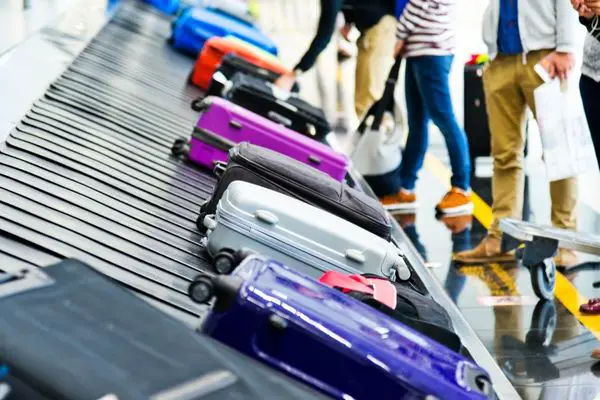
Next to losing a piece of luggage, damage on your traveling bags may be the next cause of headaches for holidaymakers. Hardside luggage, especially the popularly advertised polycarbonate, is popular because of its sturdy build, lightweight features, and elegant design.
However, one of the main complaints among owners is that scratches and dirt show very quickly. So one of the things to do to minimize such minor damage is to handle them yourself, such as carry-on luggage. But since larger-sized bags are likely destined as check-in luggage, scratches, dirt, and stain are constant hazards.
Table of Contents
Common causes of scuff marks and stains
Scuff marks and stains on luggage can be caused by a variety of factors
Rough handling
Luggage can be subjected to rough handling during travel, which can cause scuff marks and scratches.
Dirty surfaces
If luggage comes into contact with dirty or greasy surfaces, it can leave stains.
Exposure to liquids
If liquids spill on luggage during travel, they can leave stains.
Contact with other luggage
It can rub against other bags and leave scuff marks when stacked or stored together.
Age and wear
Over time, luggage can show signs of wear and tear, including scuff marks and stain.

Cleaning methods
Dirt & stain
Such types of travel bags can be cleaned using a solution composed of mild soap or liquid dishwashing detergent and lukewarm water.
Using a soft cloth, test a small area of the bag by rubbing it gently with the solution. The procedure is meant to remove dirt and stain and clean the entire shell of the luggage.
Use a plain damp cloth to wipe off any soap residue. Follow this with a completely dry cloth, leaving the shell shiny. Ensure that there is no moisture behind so the stain is completely removed.

Scuff marks
Scuff marks result from the luggage surface grazing on rough objects such as rocks or concrete. An eraser cleaning pad, mild abrasives, or toothpaste can remove scuffs and scratches from most hard luggage. Test a small area of the bag to be sure it’s appropriate for the surface.
To remove the residue of the cleaning solution, wipe the surface with a damp cloth.
Other solutions
Magic eraser: A magic eraser can work wonders on scuff marks. Simply dampen the eraser and gently rub it on the affected area. Be careful not to rub too hard or for too long, as this can damage the surface of the luggage.
Baking soda paste: Apply a paste of baking soda and water to the affected area. Let it sit briefly before gently scrubbing it with a soft-bristled brush or cloth. Rinse with water and repeat if necessary.
Vinegar: Dampen a cloth with white vinegar and gently rub the affected area. Vinegar can help remove stains and also disinfect the surface of the luggage.
Rubbing alcohol: Apply rubbing alcohol to a cloth and gently rub the affected area. This can help remove stubborn stains and scuff marks.
Toothpaste: Apply a small amount of non-gel to a cloth and gently rub it on the affected area. Rinse with water and repeat if necessary.
Always test these methods on a small, inconspicuous area of the luggage first to ensure they don’t cause any damage or discoloration.
Note: These methods are for hard-case luggage and do not apply to leather bags.
How to prevent luggage damage
Here are some tips to minimize stains and scuff marks on luggage.
Use luggage covers or protective film
These can help protect the surface of your luggage from scratches, scuff marks, and stains.
Handle luggage with care
Be gentle when handling your luggage, and avoid dropping it or dragging it across rough surfaces.
Keep luggage clean
Regularly wipe down your luggage with a damp cloth or disinfecting wipe to keep it clean and prevent stains.
Pack liquids carefully
Pack liquids in leak-proof containers and store them in a separate compartment of your luggage to avoid spills.
Avoid placing luggage on dirty or greasy surfaces
Keep your luggage off dirty or greasy surfaces, as these can leave stains.
Use luggage with durable materials
Luggage made from durable materials, such as polycarbonate or aluminum, may be less likely to show scuff marks and scratches than softer materials like fabric or leather.
Taking care of luggage stains, scuff marks, and other scratches is critical for various reasons. To begin, baggage is frequently a major investment, and preserving its quality and beauty for as long as possible is critical. Taking care of any problems as soon as they develop can help prevent further damage and extend the life of the luggage.
Second, when we travel, our luggage is sometimes the first impression people get of us. We must show ourselves in the best light possible, and a well-maintained piece of baggage can assist us.
Finally, stains and scratches might make identifying our bags on a crowded luggage carousel difficult, adding needless stress and annoyance. We can ensure that our luggage is immediately identified and can be collected promptly and simply by taking care of any damage.
In conclusion, taking care of luggage stains, scuff marks, and small damage is critical for protecting our investment, presenting ourselves effectively, and ensuring a hassle-free travel experience.








